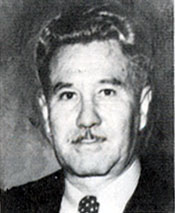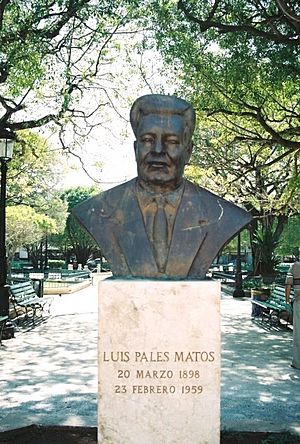Luis Palés Matos facts for kids
Quick facts for kids
Luis Palés Matós
|
|
|---|---|

Luis Palés Matos
|
|
| Born | March 20, 1898 Guayama, Puerto Rico |
| Died | February 23, 1959 (aged 60) San Juan, Puerto Rico |
| Occupation | Poet |
| Genre | Afro-Antillano |
Luis Palés Matos (born March 20, 1898 – died February 23, 1959) was a famous Puerto Rican poet. He is known for creating a special type of poetry called Afro-Antillano. He also wrote the story for "Romance Tropical," which was the first Puerto Rican movie with sound!
Contents
Growing Up
Luis Palés Matos was born in Guayama, Puerto Rico. He came from a family of poets. Both his mother and father, Vicente Palés Anés, were poets. There's even a school in Guayama named after his father.
His family really helped him love poetry. When he was only 17, he wrote and published his first book of poems called "Azaleas" (1915). In high school, he worked on the school's monthly magazine, "Mehr Licht." Sadly, his family had money problems, so he had to leave high school and find different jobs to earn a living.
The Diepalismo Movement
In 1918, Luis moved to Fajardo. He worked for the local newspaper, El Pueblo. There, he met and married a young woman named Natividad Suliveres. They had a baby boy, but sadly, his wife died from tuberculosis within a year. Luis was very sad about this. He wrote a poem called "El palacio en sombras" (The palace in shadows) to express his feelings.
Later, he moved to San Juan. He worked for daily newspapers like El Mundo and El Imparcial. In San Juan, he became friends with another poet, José I. de Diego Padró. Together, they started a new writing style called "Diepalismo." This name came from combining parts of their last names.
Afro-Antillano Poems
In 1926, a newspaper called La Democracia published "Pueblo negro" (Black town). This was the first poem of its kind, known as Afro-Antillano. This new style mixed words from Afro-Caribbean culture into Spanish poems in Puerto Rico. Some people didn't like these poems at first. They thought topics about black culture weren't important enough for serious literature.
In 1934, Palés Matos wrote the story for Romance Tropical. This was a very important movie! It was the first Puerto Rican movie with sound. It was also the second Spanish-language movie in the world to have sound. The movie was about a romance between a poor boy and a rich girl. Romance Tropical was very popular in Puerto Rico and New York. It seemed like it would make the Puerto Rican film industry famous around the world. However, there was a disagreement about who owned the movie's rights, which caused problems for the film industry.
In 1937, Palés Matos published Tuntún de pasa y grifería (Drumbeats of Kinkiness and Blackness). This collection of poems won an award from the Puerto Rican Institute of Literature. Luis Palés Matos became very famous for his writing. He is seen as one of the founders of the "Negrismo" movement, along with the Cuban poet Nicolás Guillén. However, some people in the black Puerto Rican community felt it was strange that a light-skinned man was becoming famous by writing about black issues. Even so, black Puerto Rican performers like Sylvia del Villard and Juan Boria often recited his poems.
Other important Afro-Puerto Rican and Afro-Caribbean poets include Abelardo Díaz Alfaro (1916–1999) and Angelamaria Davila (1944-2003).
His Works
Here are some of Luis Palés Matos's well-known works:
- El palacio en sombras (The Palace in Shadows)
- Pueblo negro (Black Town)
- Danza negra (Black Dance)
- Canción festiva para ser llorada (A festival song to cry for)
- Falsa canción de baquiné (False Song of a funeral for a child)
- Largarto verde (Green Lizard)
- Plena del Menéalo
- Tuntún de pasa y grifería (Drumbeats of kinkiness and blackness)
- Majestad negra (Black Majesty)
Later Life
In 1957, his collected poems, "Poesías," were praised by the Academy of the Spanish language. The University of Puerto Rico chose him to represent them at a conference. Luis Palés Matos passed away from heart failure in San Juan on February 23, 1959. He was buried in the Puerto Rico Memorial Cemetery in Carolina, Puerto Rico.
His Legacy
The Casa Luis Palés Matos in Guayama is a museum dedicated to remembering the poet.
There is a public school in Bayamón, Puerto Rico, named after Luis Palés Matos. There is also a public housing complex in Guayama named after him.
The School of Humanities at the University of Puerto Rico has a building named in his honor.
The novel "Yo-Yo Boing!" by Nuyorican poet Giannina Braschi honors the Afro-Antillano poems of Palés Matos. It also pays tribute to the lyric poetry of Julia de Burgos. These two poets are even discussed by characters in the novel.
Singer/songwriter Roy Brown started a music group in the late 1970s called Aires Bucaneros. This name comes from one of Palés Matos's poems. The group released an album in 1979 that included a song based on the poem. Roy Brown has written several other songs inspired by Palés Matos's poems since then.
See also
 In Spanish: Luis Palés Matos para niños
In Spanish: Luis Palés Matos para niños
- List of Puerto Rican writers
- List of Puerto Ricans
- Puerto Rican literature


